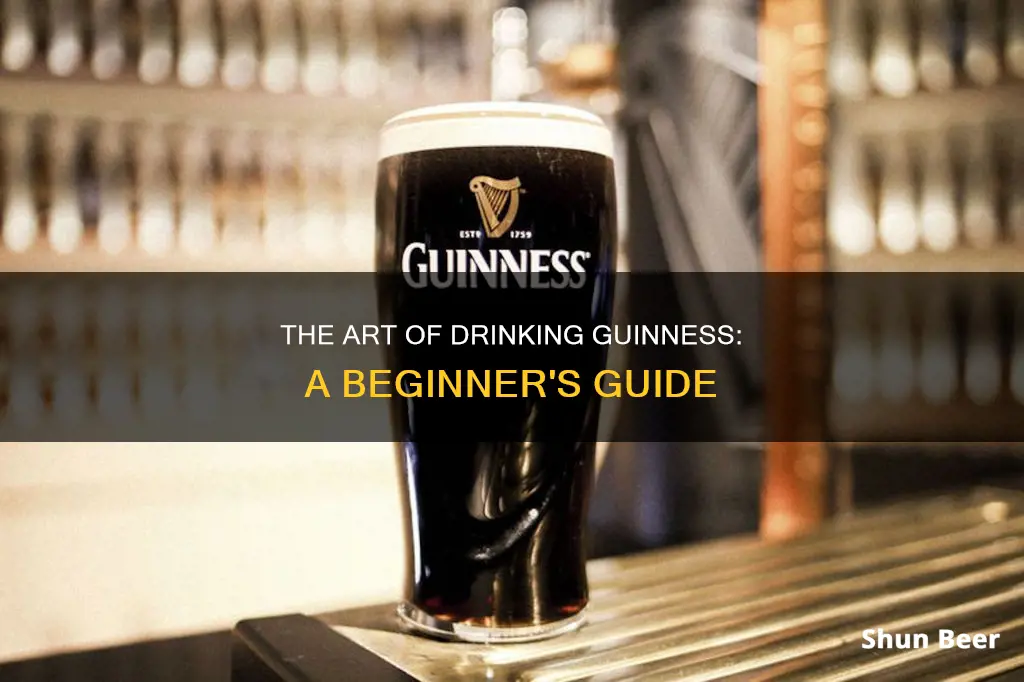
Drinking a Guinness is an art. It requires patience, practice, and appreciation. The process of drinking a Guinness is just as important as the taste itself. There is a technique to pouring the perfect pint, which involves a tulip-shaped glass, a 45-degree angle, and a two-minute settling period. But that's just the beginning. The way you drink a Guinness is also important. Some say you should chug the first quarter of the pint to get rid of the excess foam and fully experience the beer's flavour and texture. Others suggest that the perfect pint should be sipped slowly, savouring the aroma and tasting the hints of roasted malt, coffee, and dark chocolate. Whether you're a novice or a Guinness master, there's no denying that drinking a Guinness is an experience to be savoured.
| Characteristics | Values |
|---|---|
| Glassware | Official Guinness tulip-shaped pint glass |
| Angle | 45-degree angle |
| Amount | Filled to the harp above the Guinness logo |
| Settling | Left to settle for 2 minutes (119.53 seconds) |
| Topping Off | Very slowly fill to the top to create the dome-shaped head |
| Drinking | In 4 gulps |
What You'll Learn

Pouring techniques: the 45-degree angle pour or the hard pour method
There are two popular methods for pouring Guinness: the classic 45-degree angle pour and the hard pour, also known as "the flip". Both methods require four simple steps: pull, pour, settle, and enjoy. However, the technique used during the pour step is up for interpretation and is often a matter of personal preference.
The 45-Degree Angle Pour
The 45-degree angle pour is a tried-and-true method for achieving the perfect pint of Guinness. This technique involves holding the glass at a 45-degree angle and opening the tap fully, allowing the Guinness to flow into the glass. This specific angle ensures the ideal mix of nitrogen bubbles and carbon dioxide, giving Guinness its signature creamy texture and taste. It is important to maintain the 45-degree angle throughout the pour, as deviating from this angle can affect the mixing and consistency of the head.
Once the glass is about three-quarters full, the bartender should set it down and allow the surge to settle. The surge refers to the cascading effect created by the nitrogen bubbles mixing with the beer. This settling process usually takes around 119.5 seconds and results in a perfect foam head, approximately two fingers in thickness. After the surge has settled, the bartender can top off the beer with a small amount of foam, which helps retain its freshness and flavour.
The Hard Pour ("The Flip")
The hard pour, or "the flip", is an alternative method for pouring Guinness. This technique involves using a clean can and flipping it upside down into the glass, slowly lifting it out as the liquid rises. This method eliminates the need for a 45-degree angle pour and allows for a more dynamic and interactive pouring experience.
Whether you prefer the classic 45-degree angle pour or the exciting hard pour, the key to enjoying Guinness is finding the method that suits your taste and style. Experiment with different pouring techniques and discover the one that enhances your drinking experience.
Baylor Football: Beer Drinking Allowed?
You may want to see also

The perfect glass: tulip-shaped
The classic Guinness glass is tulip-shaped. The unique design helps maintain the creamy head and enhances the aroma and flavour. If you're pouring Guinness from a can or bottle, tilt the glass to a 45-degree angle while pouring to reduce excessive foam.
The tulip-shaped glass is the official glass of Guinness. Anything else is considered unworthy of the black drink. The design of the glass is to maintain the creamy head and enhance the aroma and flavour of the drink.
The tulip-shaped glass is designed to be held comfortably in the hand, with a slender waist that flares out slightly at the top. This shape allows for a comfortable grip and helps to enhance the drinking experience by allowing the flavours and aromas of the beer to concentrate and intensify.
When pouring Guinness into a tulip-shaped glass, it is important to do so at a 45-degree angle. This helps to reduce excessive foaming and creates a smoother, more velvety texture. The glass should be filled to about three-quarters full, and then allowed to rest for a moment so that the nitrogen bubbles can settle and create the famous creamy head.
Finally, top off the glass with a gentle pour to achieve the perfect head-to-beer ratio. This attention to detail and specific protocol is what makes drinking a Guinness a form of art.
Stoop Drinking: Beer, Law, and You
You may want to see also

The right amount: four sips or five?
There are differing opinions on the number of sips it should take to finish a pint of Guinness. Some sources claim that it should be done in four gigantic gulps, while others suggest that five large sips are the proper way to enjoy this iconic beer.
The four-sip method is often associated with Irish men, who are said to take their Guinness very seriously and have practised for years to perfect their technique. It is considered an art form and a cultural tradition to be able to down a pint of Guinness in four gulps. This method is also mentioned in a first-hand account, adding credibility to the claim.
On the other hand, the five-sip approach is also mentioned, though less frequently. This method suggests that you should leave five foam rings after each sip, potentially indicating a slower and more savoured approach to drinking a Guinness.
Ultimately, the number of sips may depend on personal preference and drinking style. Some people may prefer to savour the beer slowly, while others may opt for a faster approach, perhaps to avoid the excess foam that forms on this type of stout.
Regardless of the number of sips, it is clear that drinking a Guinness is more than just a casual drink. It is a cultural experience, an art, and a social ritual that is deeply rooted in Irish tradition.
Ice-Cold Beer: Good or Bad?
You may want to see also

The first mouthful: chug or savour?
There are differing opinions on how to drink the first mouthful of Guinness. Some people advocate for chugging, or "slamming", the first quarter of the pint. This is a cultural tradition and social practice, particularly when drinking Guinness, a dark stout with a creamy head. The idea is that by quickly downing the first sip, you get rid of the excess foam and can enjoy the smoother, creamier part of the drink. Guinness has a unique nitrogenation process that creates a thick, creamy head. By drinking quickly at the start, you can avoid the excess foam and experience the beer's full flavour and texture. However, there is no scientific evidence to support the idea that chugging the first quarter of a pint of Guinness or any other beer significantly improves the drinking experience. It is more of a personal preference or a way to engage in social drinking rituals.
If you want to savour your Guinness, there are a few steps you can follow. First, Guinness is traditionally served in a tulip-shaped pint glass. If you are pouring from a can or bottle, tilt the glass at a 45-degree angle to reduce foam. Fill it about three-quarters full, then let it rest to allow the nitrogen bubbles to settle and create the famous creamy head. Top off the glass with a gentle pour to achieve the perfect head-to-beer ratio. Take a moment to admire the deep dark colour with a creamy tan head. Before taking your first sip, smell the aroma of roasted malt, coffee, and chocolate that is characteristic of Guinness. When you take that first sip, let the beer roll over your taste buds so you can appreciate its velvety texture and rich flavours.
Mega Sizes and Beer: A Perfect Pairing?
You may want to see also

Pairing: what foods work with Guinness?
Guinness is a great beer to drink at the pub, but it also works as a cooking ingredient. Its rich, roasted wheat flavour lends a new dimension to dishes. It's a favourite ingredient in many Irish dishes, and it's also a perfect pairing for chocolate.
- Beef stew – a hearty meal of succulent beef, a rich, beefy broth, and fork-tender vegetables.
- Fish and chips – a traditional comfort food that goes well with a pint.
- Oysters – this delectable seafood, known for its aphrodisiac quality, is native to Ireland.
- Soda bread – an Irish staple food made with soft wheat flour, bread soda, salt, and buttermilk. Top it with smoked salmon, Irish cheddar cheese, or butter and strawberry jam.
- Beef and Guinness pie – a classic Irish dish with a homemade pastry encasing a filling of beef, vegetables, and Guinness.
- Shepherd's pie – a casserole with a foundation of vegetables and meat (beef, mutton, or lamb) topped with mashed potatoes and then baked.
- Short ribs – beef ribs are more tender and meatier than pork spare ribs.
- Smoked salmon – abundant in Ireland and packed full of nutrients and oils.
- Chocolate – the beer's natural chocolate notes intensify the flavour of chocolate, making Guinness brownies the ultimate indulgence.
Drinking Alcohol-Free Beer at Work: Is It Okay?
You may want to see also
Frequently asked questions
If you're pouring Guinness from a can or bottle, tilt the glass at a 45-degree angle while pouring to reduce foam. Fill it about three-quarters full, then let it rest for the nitrogen bubbles to settle and create a creamy head. Top off the glass gently to achieve the perfect head-to-beer ratio.
Take a moment to admire its appearance and smell its aroma. Then, let the beer roll over your taste buds and take note of its texture and flavours. Sip slowly, allowing the flavours to linger.
Leave the Guinness to settle for about two minutes, or 119.53 seconds according to the company.
There is a tradition of drinking Guinness in 4 or 5 large sips, but the most important thing is to enjoy the drink in a way that brings you pleasure.







